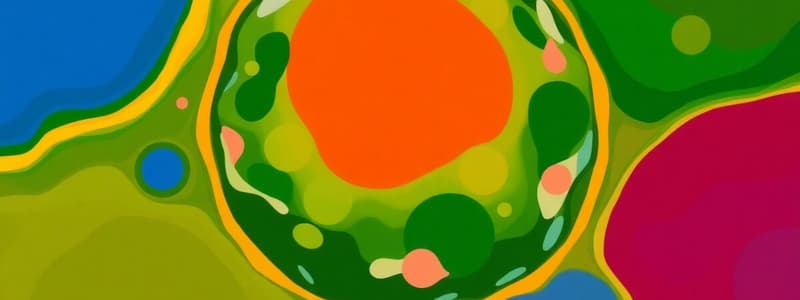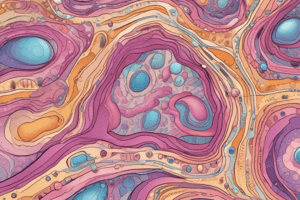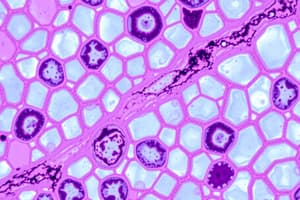Podcast
Questions and Answers
What type of collagen is primarily found in cartilage?
What type of collagen is primarily found in cartilage?
- Type III collagen
- Type IV collagen
- Type II collagen (correct)
- Type I collagen
How are osteocytes positioned within bone tissue?
How are osteocytes positioned within bone tissue?
- They are in lacunae and in direct contact with each other. (correct)
- They are scattered throughout the matrix.
- They remain in a disorganized structure.
- They are located in perichondrium.
Which of the following statements correctly describes primary/woven bone?
Which of the following statements correctly describes primary/woven bone?
- It is the primary form of bone during development and fracture repair. (correct)
- It directly replaces secondary/lamellar bone.
- It is organized with concentric lamellae.
- It has a highly mineralized matrix.
What is a key characteristic of secondary/lamellar bone?
What is a key characteristic of secondary/lamellar bone?
Endochondral ossification involves which of the following stages?
Endochondral ossification involves which of the following stages?
What is the main role of glycolipids in the cell membrane?
What is the main role of glycolipids in the cell membrane?
Which of the following cell types is responsible for modifying and completing protein synthesis initiated by the endoplasmic reticulum (ER)?
Which of the following cell types is responsible for modifying and completing protein synthesis initiated by the endoplasmic reticulum (ER)?
What type of epithelial tissue appears to have multiple layers but is essentially a single layer attached to the basement membrane?
What type of epithelial tissue appears to have multiple layers but is essentially a single layer attached to the basement membrane?
Which of the following cell types is NOT considered a fixed connective tissue cell?
Which of the following cell types is NOT considered a fixed connective tissue cell?
What is the primary function of intermediate filaments in cells?
What is the primary function of intermediate filaments in cells?
In which type of connective tissue are adipocytes predominantly found?
In which type of connective tissue are adipocytes predominantly found?
Which protein is primarily involved in anchoring cells together at zonula adherens junctions?
Which protein is primarily involved in anchoring cells together at zonula adherens junctions?
What component forms the basis of the extracellular matrix (ECM) in connective tissues?
What component forms the basis of the extracellular matrix (ECM) in connective tissues?
What type of epithelial tissue is specialized for distension and is commonly found in the urinary bladder?
What type of epithelial tissue is specialized for distension and is commonly found in the urinary bladder?
What is the primary role of macrophages in connective tissue?
What is the primary role of macrophages in connective tissue?
Which type of cartilage has a high concentration of elastic fibers and is flexible?
Which type of cartilage has a high concentration of elastic fibers and is flexible?
What is the primary function of connective tissue in the body?
What is the primary function of connective tissue in the body?
What is the predominant cell type found in brown adipose tissue?
What is the predominant cell type found in brown adipose tissue?
What is the primary function of chylomicrons in the bloodstream?
What is the primary function of chylomicrons in the bloodstream?
Which hormone is primarily responsible for stimulating appetite?
Which hormone is primarily responsible for stimulating appetite?
What differentiates hyaline cartilage from elastic cartilage?
What differentiates hyaline cartilage from elastic cartilage?
What is the main characteristic of fibrocartilage?
What is the main characteristic of fibrocartilage?
Which type of bone is primarily responsible for metabolic function?
Which type of bone is primarily responsible for metabolic function?
What cellular function do osteocytes primarily serve?
What cellular function do osteocytes primarily serve?
Which hormone helps in glucose absorption by cells?
Which hormone helps in glucose absorption by cells?
What type of cartilage lacks a perichondrium?
What type of cartilage lacks a perichondrium?
What is the primary role of osteoclasts in bones?
What is the primary role of osteoclasts in bones?
What occurs at the epiphyseal growth plate during puberty?
What occurs at the epiphyseal growth plate during puberty?
What is the significance of the perichondrium in cartilage?
What is the significance of the perichondrium in cartilage?
Which of the following is NOT a function of bone tissue?
Which of the following is NOT a function of bone tissue?
What distinguishes osteoblasts from osteoclasts?
What distinguishes osteoblasts from osteoclasts?
In which part of the bone is the endosteum located?
In which part of the bone is the endosteum located?
Flashcards
Cartilage
Cartilage
A type of connective tissue with chondrocytes in a specialized matrix, mainly type II collagen.
Bone
Bone
A type of connective tissue with osteocytes in lacunae and a mineralized extracellular matrix, mainly type I collagen.
Primary/Woven Bone
Primary/Woven Bone
Immature bone that appears first during development and fracture repair; collagen fibers are not organized and it's less mineralized.
Secondary/Lamellar Bone
Secondary/Lamellar Bone
Signup and view all the flashcards
Osteogenesis
Osteogenesis
Signup and view all the flashcards
Glycoproteins
Glycoproteins
Signup and view all the flashcards
Glycolipids
Glycolipids
Signup and view all the flashcards
Glycocalyx
Glycocalyx
Signup and view all the flashcards
Mitochondria
Mitochondria
Signup and view all the flashcards
ERAD
ERAD
Signup and view all the flashcards
Golgi apparatus
Golgi apparatus
Signup and view all the flashcards
Intermediate filaments
Intermediate filaments
Signup and view all the flashcards
Nuclear envelope
Nuclear envelope
Signup and view all the flashcards
Tight junctions
Tight junctions
Signup and view all the flashcards
Simple squamous epithelium
Simple squamous epithelium
Signup and view all the flashcards
Adipocytes
Adipocytes
Signup and view all the flashcards
Diapedesis
Diapedesis
Signup and view all the flashcards
Collagen fibers
Collagen fibers
Signup and view all the flashcards
Connective tissue proper
Connective tissue proper
Signup and view all the flashcards
Serous secretion
Serous secretion
Signup and view all the flashcards
Chylomicrons
Chylomicrons
Signup and view all the flashcards
VLDLs
VLDLs
Signup and view all the flashcards
Lipase
Lipase
Signup and view all the flashcards
Ghrelin
Ghrelin
Signup and view all the flashcards
Peptide YY
Peptide YY
Signup and view all the flashcards
Leptin
Leptin
Signup and view all the flashcards
Chondroblasts
Chondroblasts
Signup and view all the flashcards
Avascular
Avascular
Signup and view all the flashcards
Hyaline cartilage
Hyaline cartilage
Signup and view all the flashcards
Perichondrium
Perichondrium
Signup and view all the flashcards
Osteoblasts
Osteoblasts
Signup and view all the flashcards
Osteocytes
Osteocytes
Signup and view all the flashcards
Osteoclasts
Osteoclasts
Signup and view all the flashcards
Periosteum
Periosteum
Signup and view all the flashcards
Study Notes
Cells
- Glycoproteins and glycolipids form glycocalyx.
- Lipids form lipid rafts.
- Mitochondria are present in all cells except red blood cells and terminal keratinocytes.
- Endoplasmic reticulum (ER) is involved in protein degradation.
- Golgi apparatus modifies and completes protein synthesis.
- Microtubules guide vesicle movement, form near the nucleus, and extend.
- Actin filaments are involved in cell processes, movement, and anchorage.
- Intermediate filaments provide support and structure.
- Keratin is found in epithelial cells.
- Vimentin is found in mesoderm-derived cells.
- Neurofilaments are found in neurons.
- Lamins are found in the nucleus of cells.
- The nucleus is enclosed by an envelope with a perinuclear space.
- Nuclear pores regulate transport.
- Chromatin is chromosomal material.
- The nucleolus is the site of rRNA synthesis.
- Nucleoplasm is material inside the nucleus.
Epithelial
- Avascular.
- High capacity for renewal.
- Two types: covering (e.g., skin, gut) and glandular (e.g., glands).
- Papillae are evaginations in the connective tissue.
- Lamina propria binds epithelium to underlying connective tissue (contains type IV collagen, glycoproteins, and proteoglycans).
- Basement membrane forms from basal and reticular lamina.
- Intercellular junctions include tight junctions (zonula occludens), zonula adherens, desmosomes (macula adherens), hemidesmosomes, and gap junctions.
- Cadherins anchor cells together to suppress epithelial tumors.
- Integrins interact with basal lamina (laminin and type IV collagen) and extracellular matrix (ECM) of connective tissue.
- Gap junctions form diffusion channels between adjacent cells.
- Cilia move mucus and other substances.
- Microvilli increase surface area.
- Stereocilia are long microvilli found in specific locations.
Connective Tissue
- Connects tissues.
- No free surface.
- Has nerve supply (except cartilage).
- Highly vascular (except cartilage).
- Provides support, surrounds, and connects tissues.
- Forms the framework of the body.
- Defends against invasion.
- Protects delicate organs.
- Transports.
- All connective tissue develops from mesenchyme.
- ECM consists of protein fibers (collagen, elastic, reticular) and ground substance (filler).
- Fixed cells include fibroblasts/fibrocytes, chondrocytes, osteocytes, and adipocytes.
- Wandering cells include macrophages, mast cells, and plasma cells.
- Adipose tissue (fat) includes white (unilocular) and brown (multilocular) adipocytes.
- White fat stores energy; brown fat produces heat.
Cartilage
- Apert's syndrome: Adjacent bones fuse.
- Chondroblasts produce extracellular matrix (ECM); chondrocytes reside in lacunae.
- Cartilage is avascular and has no nerves or lymphatic vessels.
- Perichondrium surrounds cartilage, except fibrocartilage and articular cartilage
- Types include hyaline, elastic, and fibrocartilage.
- Hyaline cartilage is the most common type and forms parts like tracheal rings and articular surfaces.
- Elastic cartilage is found in structures where flexibility is needed
- Fibrocartilage is found in structures with high stress (e.g., intervertebral discs).
Bone
- Osteoblasts form bone tissue; osteocytes reside in lacunae.
- Bone matrix (ECM) is calcified, composed of type I collagen, and provides structural support.
- Bone functions include support, protection, mineral homeostasis, and hematopoiesis.
- Compact (cortical) and spongy (cancellous/trabecular) bone are the two main types.
- Bone remodeling involves resorption and formation of bone tissue (osteoclasts and osteoblasts).
- Periosteum covers the outer surface of bone; endosteum lines the inner surface.
Studying That Suits You
Use AI to generate personalized quizzes and flashcards to suit your learning preferences.




